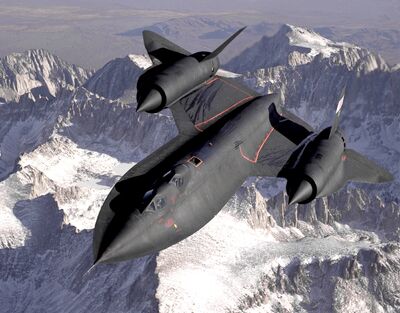The Lockheed SR-71 Type A Aka Blackbird Is a strategic reconnaissance aircraft (hence the "SR": Strategic Reconnaissance) long-range developed by Lockheed from the projects YF-12 and A-12.
Description[]
The famous Clarence "Kelly" Johnson is the name behind many of the advanced concepts of aerodynamics that airplane. Its fuselage was made of alloys titanium to withstand the high temperatures around 200-300 degrees Celsius caused by air friction

Lockheed SR-71 Blackbird
due to the high speed attained.
As its fuselage was made on plates in order to swell during the flight, the SR-71 is known to leak when they're down, by its hydraulic fluid freeze at temperatures of 30 °C and the peculiar mode of activation of the engines. Because the J-58 turbine large and too heavy (9-stage axial flow compression) to a common pneumatic system, the activation was done by a V-8 engine poisoned by gears connected directly to the turbine shaft in the first years (now the activation was done otherwise written below).
His flight at high temperatures would not be possible without the special fuel developed for him, the JP-7 and little sticky so volatile that it was possible to erase easily a match in a bucket of JP-7. JP-7 not burning with the engine cold, so at the hour of departure was necessary to preheat the turbines with another "formula for witch," the Trimethyl borate - that was a characteristic green flame. For the fuselage, all supersonic aircraft need sharp edges on the cockpit, engines and wings, wich the SR-71 is no exception.
The Blackbird was originally built with a nacelle, for only one pilot, were named A-12 in its second version, called the SR-71, had two nacelles for two crew seats in tandem, leaving the pilot in nacelle front, while the operator of going back in the cockpit. There was also the B version used for training, which had two nacelles, and accommodated two pilots in the cockpit rear was higher for the lead. For missions at high altitudes and speeds, both the crew wore a pressure suit, reminiscent of the early costumes astronauts. For its construction, machines were developed tools (machine tools) with the specific purpose of building components to this plane. When the closure of its production, the machines were destroyed, making it impossible so new parts and / or units of the SR-71 would be made again, and with the end of Cold War, Was no longer viable after using a plane flying hour cost as high.
For various reasons, the SR-71 was disabled. Among them, political factors, operating costs and the advent of satellites. Only three are held in place by NASA to study. This plane was flying so high and so fast that, pursued by a ground to air missile the classic avoidance maneuver was simply to accelerate. Based on Beale in California, The unit equipped with SR-71 were on different bases, mainly in England and Japan, To provide air cover in the world.
In the operational altitude, the SR-71 could do the surveillance of an area of 270,000 square kilometers per hour, allowing it to operate in North Vietnam, in China, in Soviet Union, in Cuba or North Korea without entering its airspace. None of the 33 SR-71 was shot made until today, although 12 units were lost in accidents. In one of his last flights outside the U.S., an SR-71 was shown on air on Monday Paris, And returning to the U.S. hit a new record speed. Due to time zone, the plane came to the U.S. about four hours before the time when it took off from Paris. kool now can u please edit this and tell me about the flight control and the fuelage more thanks lol..
Specifications[]
General Characteristics[]
- Crew: 2
- Payload: 3,500 lb (1,600 kg) of sensors
- Length: 107 ft 5 in (32.74 m)
- Wingspan: 55 ft 7 in (16.94 m)
- Height: 18 ft 6 in (5.64 m)
- Wing area: 1,800 ft2 (170 m2)
- Empty weight: 67,500 lb (30,600 kg)
- Loaded weight: 170,000 lb (77,000 kg)
- Max takeoff weight: 172,000 lb (78,000 kg)
- Powerplant: 2× Pratt & Whitney J58-1 continuous-bleed afterburning turbojets, 32,500 lbf (145 kN) each
- Wheel track: 16 ft 8 in (5.08 m)
- Wheel base: 37 ft 10 in (11.53 m)
- Aspect ratio: 1.7
Performance[]
- Maximum speed: Mach 3.2+ (2,200+ mph, 3,530+ km/h, 1,900+ knots) at 80,000 ft (24,000 m)
- Range: 2,900 nmi (5,400 km)
- Ferry range: 3,200 nmi (5,925 km)
- Service ceiling: 85,000 ft (25,900 m)
- Rate of climb: 11,810 ft/min (60 m/s)
- Wing loading: 94 lb/ft² (460 kg/m²)
- Thrust/weight: 0.382
See also[]
The original article can be found at Lockheed SR-71 Blackbird and the edit history here.